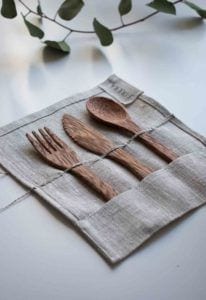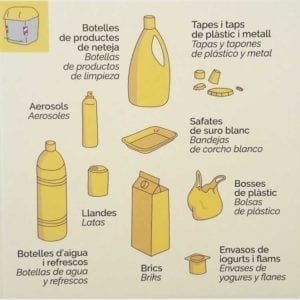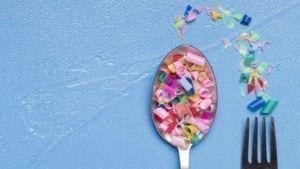
I’m going to ask you a favor, while you’re sitting reading this post look around, how many pieces of plastic can you see? The number of things with plastic will depend on which part of your house you’re in, but I’m sure you are already thinking about all the things you have in all the rooms, right? This is what happened to me when I started being more aware of the amount of plastic I consumed. I thought it wasn’t so much until one day, in the bathroom, I realized that all my products – except for the soap and my newly purchased shampoo – were in plastic containers; at that moment I had the realization that dropped like a bucket of cold water: it was time to start – really – living plastic free.
During the last few years I’ ve been quite aware of the amount of plastic I consume and the problem this represents for the planet; but many times I fail to stop using it at 100%. It happens to me a lot when I go out and assume that everyone thinks the same as me but they put a straw in my drink; or when I take my reusable bag to buy take away food but they give me some kind of sauce in a plastic container.
When these things happen to me, I get a lot of remorse and I calm myself down by recycling it in the yellow bin (let’s say it’s like a balm that calms my remorse, but in my case it’s not the solution)
Living plastic free in July
That’s why I’ll be at my best this month! I’ ve decided that during the whole month I will try to be more aware of those small actions that I can still improve to continue my path towards living plastic free; and of course, joining the global challenge Plastic free July.
This movement was started by Rebecca Prince-Ruiz, the founder of The Plastic Free Foundation in 2011 together with a small team from the government of Western Australia. This initiative has been replicated around the world.
It’s estimated that 250 million people took part in 2019 alone; who reduced their household waste and recycling by 23kg per person per year; contributed to a total saving of 825 million kg of plastic waste per year; and best of all, 9 out of 10 people made changes that became habits, isn’t that great?
The best part of the challenge is that you can do it yourself or join millions of people by registering here
Living plastic free: how to
This will be my second year participating in the challenge. Last year I tried, but if I remember correctly, I think that on the second day of July I had already bought or used something with plastic. So this year will be different; I’ll be keeping a diary (I’ ll be 100% honest, I promise) in which I’ll write down all the moments or actions in which I avoided using plastic and what I used instead; as well as those moments in which I did use products that had plastic in them.
I don’t pretend that all of us keep a diary of our plastic consumption, but these are some of the steps we can take to living plastic free and perhaps, in the near future, become zero waste.
1.- Identify where you use the most plastic.
I don’t mean the physical place, but the area of your life. It can be in hygiene and beauty products, when going grocery shopping, when eating out or going for a walk, when going shopping or when going out to have fun. Once you have identified it, research where you can find the same products but made with sustainable materials. Fortunately there are already a lot of places where you can get them and if you live in Valencia, I recommend you visit Marla and Antonio at Terreta Neta.
WAIT! Before you throw all the plastic in your life into the yellow bin, make sure you’ ve used every last one of it. If you throw it away just to avoid having plastic in your life, you’ ll be generating more waste, which is what we want to avoid.
2.- Avoid using single-use plastics.

Single-use plastics can include bags, food containers, straws, cutlery, cups and the most common of all, water bottles. I know what you’re going to think, I sound like a broken record, but this is one of the easiest things to overlook.
We’re out and we suddenly decide to stop and get some dinner to go or go to the store to buy something, but we didn’t bring any of our anti-plastic kit! We decide that this time nothing happens … and it’s true. The road to living plastic free can be difficult at first, but with this recommendations I think it’ ll be a little easier for you.
Think about your normal routine and whether you do regular or impulse shopping when you go out. What do I mean? When you go out in the morning to work you pass by the same cafeteria for a coffee, usually you don’t buy anything else but you crave a croissant. For this purchase, you bring your reusable coffee cup because you do it from Monday to Friday, but you didn’t bring anything for the croissant. Even if you don’t do it every day, for those impulse moments (which are completely acceptable), you can leave a reusable napkin next to (or inside) the coffee cup in case you decide that it’s okay to have a treat.
This idea can be applied to always carry a reusable bag with you in case you need to buy some food that you’ve forgotten or carry your reusable bottle with you in case you’re thirsty or want to buy some refreshing drink on the way. Thinking about our actions and routines will make the transition to living plastic free or being zero waste easier.
3.- Leave frozen food behind.
This is one of the things that is hardest for us to do. Who doesn’t like the convenience of not having to cook? It’s practical and it’s easy, but it generates a lot of trash. I’m not a nutrition and food specialist, but I’ll tell you a (very) short story: I usually buy the frozen salad pack and it makes my life in the kitchen much easier.
One day I realized that I didn’t have any left, but I had all the ingredients to make it, so I shook off my laziness and prepared my food as I normally do; and the difference in taste was amazing! Preparing the salad didn’t take that long and the truth is that the difference in taste was so great, that I don’t think I’ll go back to the frozen one.
So the advice I can give you after this experience, is to buy the food you normally buy frozen at the market -using reusable bags and containers- and on the weekend (it can be on Sunday afternoon) cook and freeze it; that way you have the advantages of all the flavor and practicality, without the need to generate waste.
4.- One of the three R’s: Reuse.
If you already have it, try to get a second or even third use out of it. Although it’s not recommended to reuse plastic containers to store food because of the chemicals that plastic can have, you can reuse them for other things.
You can reuse them for storage or to do DIY activities with the kids during the summer. Another way to reuse your containers is to buy the same product in bulk. Many stores already have cleaning and hygiene products for sale in this format and actually encourage you to bring your own containers or donate them to them.
5.- The most famous of the R’s: Recycle!
I know that living plastic free overnight can be very difficult. There may be days when we forget or just couldn’t help it; when that happens, let’s recycle properly and throw the containers into the yellow bin. In case you don’t know, the yellow bin is where you throw plastic containers, bricks and cans.
According to ecoembes the following types of trash must be deposited in the yellow bin:

- Plastic bottles
- Cans
- Plastic, metal and sheet metal caps and plugs
- Aluminium trays
- Film and aluminum foil
- Aerosols
- Deodorant bottles
- Plastic bags (except garbage bags)
- Yoghurt pots and lids
- Briks: milk, juice, soup, etc.
- White cork trays
- Toothpaste tubes
On their website, you can find more information about the garbage that does NOT go in the yellow bin, the recycling process and some curiosities about the benefits of recycling these containers.
6.- Look out for microplastic and microfibers.
When we think of plastic pollution, we think of the big pieces we see and use in our daily lives; but what about the smaller pieces? Surely you have heard of microplastics and how they make up a large part of the problem in ocean pollution.
According to the National Oceanic and Atmospheric Administration (NOAA) microplastics have two sources: the first being those that degrade or separate from larger plastics and the second being those that are manufactured for use in certain personal care products such as scrubs, toothpaste, etc., also called microbeads.
In addition to these microplastics, there is another major source of water contamination, which are microfibers. Like microplastics, microfibers are small (or tiny) pieces of fiber that come off of our clothes every time we wash them. This problem is especially problematic because about 70% of today’s clothes are made of synthetic fibres and we all wash our clothes quite often.
Here comes the disturbing part. The problem with microplastics and microfibers is that when they reach the oceans, animals mistake them for food and give a feeling of being full but without any nutrients, so many – literally – starve to death. In other cases, the animals eat these microplastics, they are caught for human consumption and they end up in a delicious seafood dish seasoned with some plastic; which means that we are consuming plastic when we eat some seafood.

If you are interested in knowing more about this topic, I recommend you to watch the documentary “A plastic Ocean” which I talk about in my last post “The 6 documentaries to be a responsible consumer.”
7.- Think before you buy.
As you will see, I tried not to burden you with the same old thing (I hope I succeeded); because I think that if we’ re already aware of the problem, we need to go a step further than just replacing disposable products with reusable ones.
That’s why in addition to the above actions, which contribute greatly to reducing plastic pollution, it’s best to reduce and completely eliminate its use. We achieve this with what I consider the easiest action to apply, and not only when we talk about the use of plastics: think before you buy.
When you need a new toothbrush, you have run out of floor cleaner, you want a new pair of summer sandals or you have to buy a gift, think about what, how and who you are buying from. Think about whether that product has any plastic parts and whether at the end of its life cycle it can be recycled or reused. Think if the fibers of the shirt are natural or if they’ re polyester or nylon that come from oil and if you want to go even further, think if it was made by a company that exploits its workers.
Let’s remember that as consumers we have the power when purchasing and with this simple action, we can create a big change. Aside of a healthier one for the planet and for ourselves.
Living plastic free takes time
As I said at the beginning of the post, and I’ve done it on other occasions, the path towards being a responsible consumer, living plastic free and living a sustainable life in all senses takes time.
It doesn’t happen overnight, and although we see people doing a thousand things to help the environment, we must think that they’ve been doing it for much longer than we have and that we can learn a lot from them.
I still have a hard time living plastic free and I still have a long way to go to live a zero waste life, but I try not to get discouraged. It comforts me to know that there are people around me who are starting to make these small changes (sometimes I like to think that I’ve inspired them) and that if we’re all more aware we’ll be able to see the difference or at least make a difference for the next generation.

So, let’s go all out for this plastic free July! I hope you’ll join this challenge and don’t forget to read my plastic free diary in August!
P.S.: Be sure to visit our storeto see the sustainable and ecological products that can help you on this journey to start living plastic free.



